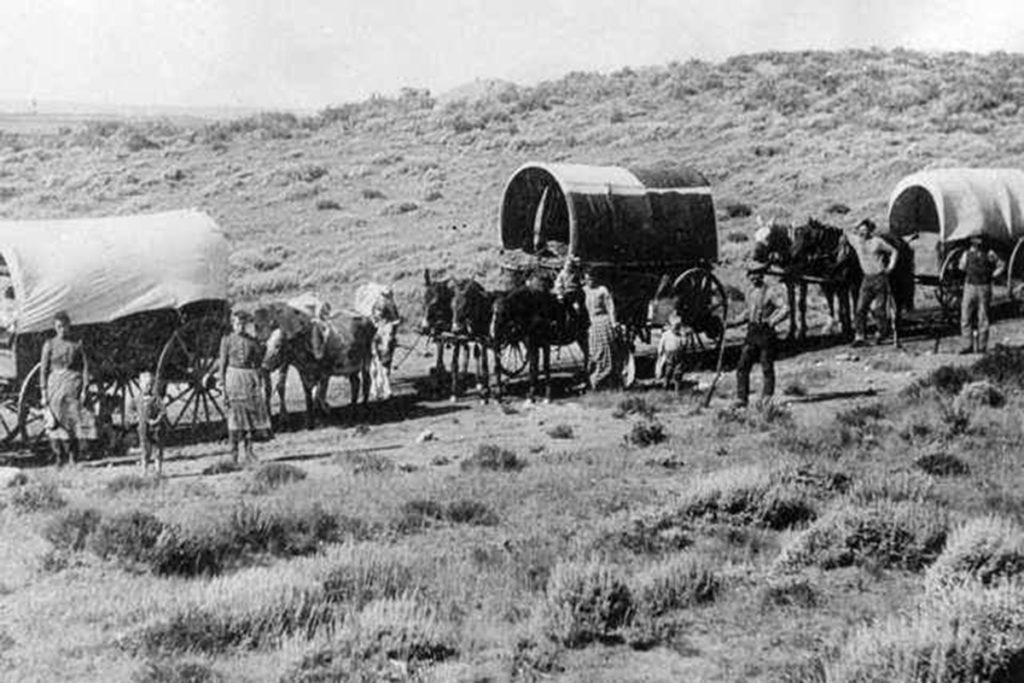A typical wagon train on the move in 1855, Contrary to popular opinion, the trains, often attempted to traverse wide areas in parallel lines, as you can see here, with a second line forming along side the first, On the Santa Fe Trail, the big freight wagons would sometimes travel four abreast where the space permitted it, This strategy was utilized for protection, When the wagon train would
1841 Detail, First Wagon Train West
Donner Party
Background
Wagon Trains
The French
Wagon train
Your blog regarding the Keil/Bethelite wagon train west in 1855 caught my eye I’ve been able to read several excerpts from William Keil’s letters – they were pretty interesting My great grandfather Frederick William Keil was born in Bethel Mo He died at age 97 yrs in 1969, His father, August, was the colony doctor and his mother, Rosina Forstner Keil, was the daughter of George and

Wagons In The 1800s Photos and Premium High Res Pictures
Indians attacked the wagon trains; however, of the 10,000 deaths that occurred from 1835 to 1855, only 4 percent resulted from Indian attacks, Cholera, smallpox, and firearms accidents were the chief causes of death on the trail, Food, water, and wood were always scarce, and the settlers often encountered contaminated water holes, During summer, the trail was crowded with wagon trains, army
1800s american western frontier with wagon train going westward onto the great plains antique engraving: sunshine and shade engraving – wagons in the 1800s stock illustrations Last Chance or Bust Wagon Train Confronted by Native Americans Western Frontier 1870,
Wagon Train
Daily Life On A Doomed Wagon Train
Information about Wagon Trains
They would travel in packs — wagon trains a collective of like-minded folk guided by someone who claimed to know where they were going and the best way to get there though that didn’t always work out — ask the Donner PartyMigration began in earnest with the opening of the Santa Fe Trail in the 1820s, then picked up considerably with wagons headed for Oregon and California in the …
The Wagon Many of the wagons used in wagon trains in the mid 1800’s were simply farm wagons, not at all like the heavy, sway-backed Consetoga wagons used in Pennsylvania at that time, Seldom, also, were they called “prairie schooners”, Light but sturdy, they had three basic parts -the bed, the running gear, and the top, The bed was a wooden box about nine or ten feet long and four feet wide
Wagon Trains, Pioneers and Sour Dough Starter, 10/8/2013 6 Comments Welcome to the wagon train, It’s a hard journey but I know you can make it, Pioneers have been taking this journey for years now and you are just as strong as them, Can you hear the creak of the wagon and the turning, grinding wheels, The horse’s heavy breathing and the monotonous plod of the hoofbeats have gone …
The tire became loose on a wheel of the next to the last wagon in a freight train, the men stopped to tighten it, while the rest of the train moved on, not thinking of danger, and was out of sight in a few minutes, An hour later some of the men came back to see what kept them, There they were – dead and scalped – horses gone, and wagons on fire, The Indians had taken all the freight they could
What You Probably Didn’t Know About Covered Wagons
wagon trains in the 1800s
Westward Expansion Trails
WAGON TRAINS, For purposes of protection and efficiency, traders and emigrants of the trans-Mississippi West before 1880 customarily gathered their wagons into more or less organized caravans or trains, William L, Sublette, a partner in the reorganized Rocky Mountain Fur Company, conducted a ten-wagon, mule-drawn train over the Oregon Trail from St, Louis, Missouri, as far as …
Wagon Trains, Pioneers and Sour Dough Starter
Crossing the Plains, 1865
1841 – Detail, May 1, 1841 – The first wagon train to California, with sixty-nine adults and several children, leave from Independence, Missouri, The journey would take until November 4, Within two years, it would be considered a small excursion, when wagon trains would reach one thousand people in settlement of the west, but this wagon train
a3Genealogy: Wagon Trains 1840-1860
Wagon train, caravan of wagons organized by settlers in the United States for emigration to the West during the late 18th and most of the 19th centuries,Composed of up to 100 Conestoga wagons q,v,; sometimes called prairie schooners, wagon trains soon became the prevailing mode of long-distance overland transportation for both people and goods, , Wagon-train transportation moved westward